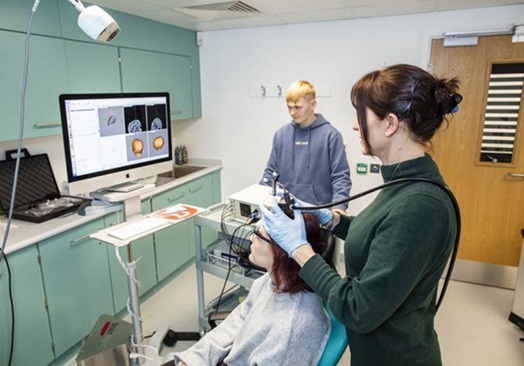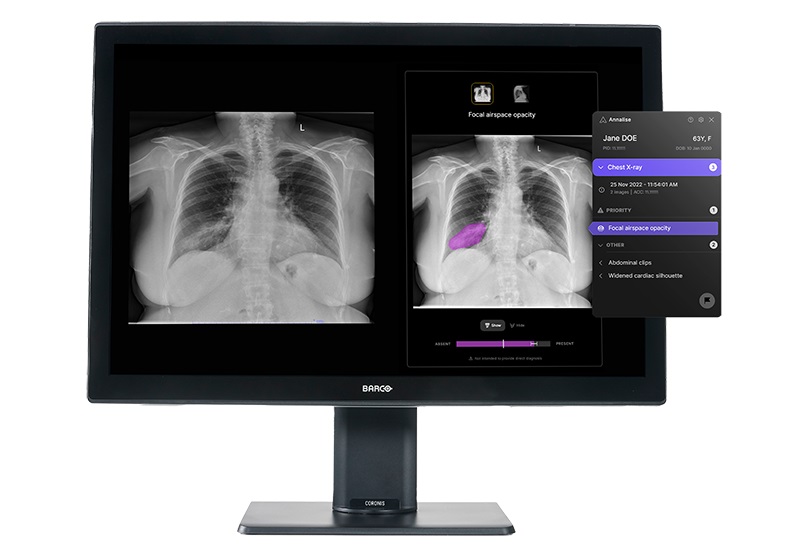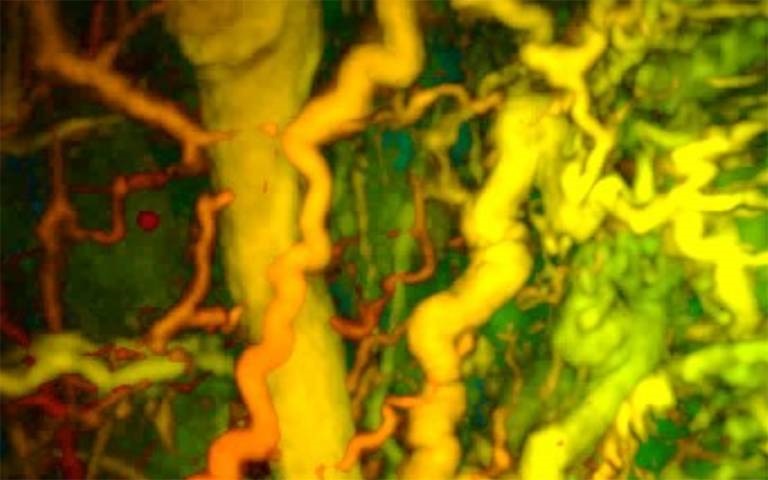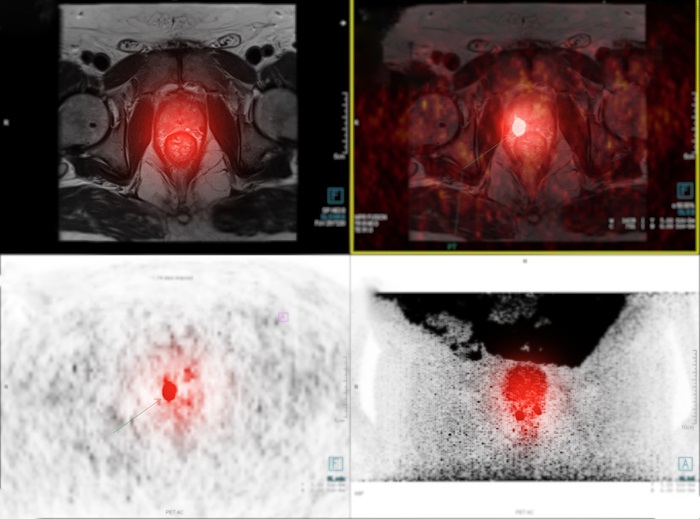Novel Technique Uses Lasers to Image Living Tissues
|
By Daniel Beris Posted on 16 Nov 2016 |

Image: Researchers found embedded nanoparticles could improve regular microscopes six-fold (Photo courtesy of MIT).
A new imaging technique uses tiny embedded particles to illuminate cellular structures in deep tissue and other dense and opaque materials.
Developed by researchers at the Massachusetts Institute of Technology (MIT, Cambridge, MA, USA), Massachusetts General Hospital (MGH; Boston, USA), and the Jožef Stefan Institute (Ljubljana, Slovenia), the particles are made from lead iodide perovskite, a material that absorbs and traps light efficiently. When a laser beam is projected at the particles, they emit a normal, diffuse fluorescent light. But if the incoming laser's power is tuned to certain threshold, the particles will instantly generate laser light.
The tiny, 6-micron-long particles have a rod-shaped geometry – much like chopsticks – and can allow a specific wavelength of light to bounce back and forth along the particles' length, resulting in images that can be captured at resolutions six times higher than current fluorescence-based microscopes. According to the researchers, the optical technique, called LAser particle Stimulated Emission (LASE) microscopy, could be used to image a specific focal plane, or a particular layer of biological tissue. The study was published on November 4, 2016, in Physical Review Letters.
“Theoretically, scientists can shine a laser beam into a three-dimensional sample of tissue embedded throughout with laser particles, and use a lens to focus the beam at a specific depth,” said lead author MIT graduate student Frederick Sangyeon Cho, MSc. “Only those particles in the beam's focus will absorb enough light or energy to turn on as lasers themselves. All other particles upstream of the path's beam should absorb less energy and only emit fluorescent light.”
“Our idea is, why not use the cell as an internal light source? We can collect all this stimulated emission and can distinguish laser from fluorescent light very easily using spectrometers,” concluded Mr. Cho. “We expect this will be very powerful when applied to biological tissue, where light normally scatters all around, and resolution is devastated. But if we use laser particles, they will be the narrow points that will emit laser light. So we can distinguish from the background and can achieve good resolution.”
Perovskite, named after Russian mineralogist Lev Perovski (1792–1856), is composed of calcium titanate, and was discovered in the Ural Mountains by Gustav Rose in 1839. Perovskites have excellent light-emitting properties, and have been used to make light-emitting diodes and optically pumped lasers. They may also be used to design solution-processed lasers that can be tuned across the entire visible and near infrared (NIR) spectrum by changing the chemical composition of the perovskite film.
Related Links:
Massachusetts Institute of Technology
Massachusetts General Hospital
Jožef Stefan Institute
Developed by researchers at the Massachusetts Institute of Technology (MIT, Cambridge, MA, USA), Massachusetts General Hospital (MGH; Boston, USA), and the Jožef Stefan Institute (Ljubljana, Slovenia), the particles are made from lead iodide perovskite, a material that absorbs and traps light efficiently. When a laser beam is projected at the particles, they emit a normal, diffuse fluorescent light. But if the incoming laser's power is tuned to certain threshold, the particles will instantly generate laser light.
The tiny, 6-micron-long particles have a rod-shaped geometry – much like chopsticks – and can allow a specific wavelength of light to bounce back and forth along the particles' length, resulting in images that can be captured at resolutions six times higher than current fluorescence-based microscopes. According to the researchers, the optical technique, called LAser particle Stimulated Emission (LASE) microscopy, could be used to image a specific focal plane, or a particular layer of biological tissue. The study was published on November 4, 2016, in Physical Review Letters.
“Theoretically, scientists can shine a laser beam into a three-dimensional sample of tissue embedded throughout with laser particles, and use a lens to focus the beam at a specific depth,” said lead author MIT graduate student Frederick Sangyeon Cho, MSc. “Only those particles in the beam's focus will absorb enough light or energy to turn on as lasers themselves. All other particles upstream of the path's beam should absorb less energy and only emit fluorescent light.”
“Our idea is, why not use the cell as an internal light source? We can collect all this stimulated emission and can distinguish laser from fluorescent light very easily using spectrometers,” concluded Mr. Cho. “We expect this will be very powerful when applied to biological tissue, where light normally scatters all around, and resolution is devastated. But if we use laser particles, they will be the narrow points that will emit laser light. So we can distinguish from the background and can achieve good resolution.”
Perovskite, named after Russian mineralogist Lev Perovski (1792–1856), is composed of calcium titanate, and was discovered in the Ural Mountains by Gustav Rose in 1839. Perovskites have excellent light-emitting properties, and have been used to make light-emitting diodes and optically pumped lasers. They may also be used to design solution-processed lasers that can be tuned across the entire visible and near infrared (NIR) spectrum by changing the chemical composition of the perovskite film.
Related Links:
Massachusetts Institute of Technology
Massachusetts General Hospital
Jožef Stefan Institute
Latest General/Advanced Imaging News
- Low-Dose CT Screening for Lung Cancer Can Benefit Heavy Smokers
- Non-Invasive Imaging Technique Accurately Detects Aggressive Kidney Cancer
- AI Algorithm Reduces Unnecessary Radiation Exposure in Traumatic Neuroradiological CT Scans
- New Solution Enhances AI-Based Quality Control and Diagnosis in Medical Imaging
- AI Tool Detects Cervical Spine Fractures from CT Scans
- Flat Panel Detector Speeds Up Imaging and Diagnosis

- AI Tool Accurately Predicts Stroke Outcomes After Arterial Clot Removal Using CTA Scans
- Motion Compatible Neuroimaging Device Enables Walking PET Brain Scans
- Routine CT Screening Can Identify Individuals at Risk of Type 2 Diabetes
- AI-Based Algorithm Significantly Reduce Miss Rates for Pulmonary Embolism on CT Imaging
- Next Gen Interactive Plaque Analysis Platform Assesses Patient Risk in Suspected Coronary Artery Disease
- Breakthrough Brain PET System Aids Diagnosis of Neurological Disorders
Channels
Radiography
view channel
Novel Breast Cancer Screening Technology Could Offer Superior Alternative to Mammogram
Breast cancer represents 15.5% of new cancer cases and 7% of cancer-related deaths in the United States. Approximately 13.1% of women will be diagnosed with breast cancer during their lifetime.... Read more
Artificial Intelligence Accurately Predicts Breast Cancer Years Before Diagnosis
Mammography screening helps reduce breast cancer mortality; however, its accuracy is not perfect. For decades, various strategies have been employed to enhance the interpretive performance of mammography,... Read more (1).jpg)
AI-Powered Chest X-Ray Detects Pulmonary Nodules Three Years Before Lung Cancer Symptoms
Lung cancer has one of the worst survival rates among all cancers, with more than two-thirds of patients diagnosed at an advanced stage, making curative treatment no longer viable. The issue of missed... Read moreMRI
view channel
Groundbreaking AI-Powered Software Significantly Enhances Brain MRI
Contrast-enhanced magnetic resonance imaging (MRI) utilizes contrast agents to illuminate specific tissues or abnormalities, leading to improved visualization and more comprehensive information.... Read more.jpeg)
MRI Predicts Patient Outcomes and Tumor Recurrence in Rectal Cancer Patients
Colorectal cancer is on the rise among younger adults—those under 50—while it has been declining in older populations. It is estimated that approximately 1 in 23 men and 1 in 25 women will be diagnosed... Read more
Portable MRI System Dramatically Cuts Time-To-Scan vs. Conventional MRI in Stroke Patients
Imaging of the brain is crucial for the management of acute stroke and transient ischemic attack. Key roles of imaging include confirming the diagnosis, determining treatment eligibility, indicating the... Read moreUltrasound
view channel
Ultrasound Can Identify Sources of Brain-Related Issues and Disorders Before Treatment
For many years, healthcare professionals worldwide have relied on ultrasound to monitor the growth of unborn infants and evaluate the health of internal organs. However, ultrasound technology, once primarily... Read more
New Guideline on Handling Endobronchial Ultrasound Transbronchial Needle Samples
Endobronchial ultrasound-guided transbronchial needle aspiration (EBUS-TBNA) has become the standard procedure for the initial diagnosis and staging of lung cancer; however, there is limited guidance on... Read more
Groundbreaking Ultrasound-Guided Needle Insertion System Improves Medical Procedures
Ultrasound-guided neuraxial procedures have traditionally been hampered by technical challenges, such as the need for three hands to manage the needle, probe, and syringe simultaneously, steep needle angles... Read moreNuclear Medicine
view channel
PET Software Enhances Diagnosis and Monitoring of Alzheimer's Disease
Alzheimer’s disease is marked by the buildup of beta-amyloid plaques and tau protein tangles in the brain. These deposits of beta-amyloid and tau appear in various brain regions at differing rates as the brain ages.... Read more.jpg)
New Photon-Counting CT Technique Diagnoses Osteoarthritis Before Symptoms Develop
X-ray imaging has evolved significantly since its introduction in 1895. This technique is known for capturing images quickly, making it ideal for emergency situations; however, it does not provide adequate... Read moreImaging IT
view channel
New Google Cloud Medical Imaging Suite Makes Imaging Healthcare Data More Accessible
Medical imaging is a critical tool used to diagnose patients, and there are billions of medical images scanned globally each year. Imaging data accounts for about 90% of all healthcare data1 and, until... Read more
Global AI in Medical Diagnostics Market to Be Driven by Demand for Image Recognition in Radiology
The global artificial intelligence (AI) in medical diagnostics market is expanding with early disease detection being one of its key applications and image recognition becoming a compelling consumer proposition... Read moreIndustry News
view channel.jpeg)
Philips and Medtronic Partner on Stroke Care
A stroke is typically an acute incident primarily caused by a blockage in a brain blood vessel, which disrupts the adequate blood supply to brain tissue and results in the permanent loss of brain cells.... Read more
Siemens and Medtronic Enter into Global Partnership for Advancing Spine Care Imaging Technologies
A new global partnership aims to explore opportunities to further expand access to advanced pre-and post-operative imaging technologies for spine care. Medtronic plc (Galway, Ireland) and Siemens Healthineers... Read more
RSNA 2024 Technical Exhibits to Showcase Latest Advances in Radiology
The Radiological Society of North America (RSNA, Oak Brook, IL, USA) has announced highlights of the Technical Exhibits at RSNA 2024: Building Intelligent Connections, the Society’s 110th Scientific Assembly... Read more














.jpg)




